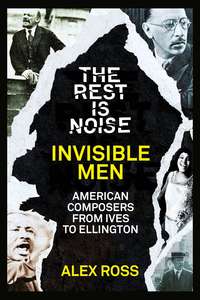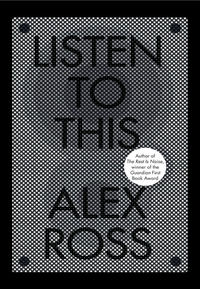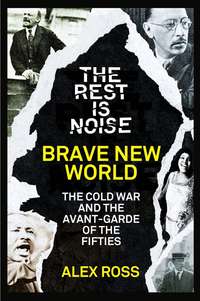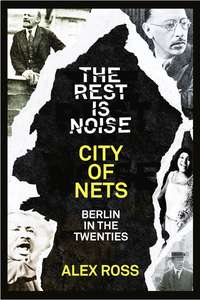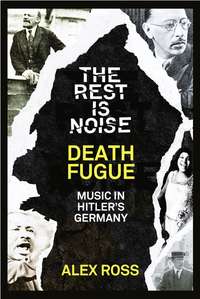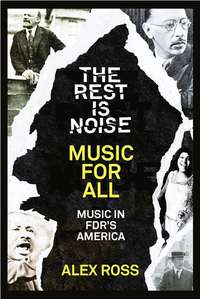
Полная версия
The Rest Is Noise Series: Zion Park: Messiaen, Ligeti, and the Avant-Garde of the Sixties

This is a chapter from Alex Ross’s groundbreaking history of 20th century classical music, The Rest is Noise.
It is released as a special stand-alone ebook to celebrate a year-long festival at the Southbank Centre, inspired by the book. The festival consists of a series of themed concerts. Read this chapter if you’re attending concerts in the episodes
1960s: Counterculture and Revolution and Politics and Spirituality in the Late Twentieth Century
Alex Ross, music critic for the New Yorker, is the recipient of numerous awards for his work, including an Arts and Letters Award from the American Academy of Arts and Letters, the Belmont Prize in Germany and a MacArthur Fellowship. The Rest is Noise was his first book and garnered huge critical acclaim and a number of awards, including the Guardian First Book Award and the National Book Critics Circle Award. He is also the author of Listen to This.
ZION PARK
MESSIAEN, LIGETI, AND THE AVANT-GARDE OF THE SIXTIES
From The Rest Is Noise by Alex Ross

Contents
Zion Park
Notes
Suggested Listening and Reading
Copyright
About the Publisher
13
ZION PARK
Messiaen, Ligeti, and the Avant-Garde of the Sixties
“I have found that it is not to be,” Adrian Leverkühn declares, in his bloodcurdling meditation on Beethoven’s Ninth Symphony. “The good and the noble, what they call the human, despite the fact that it is good and noble. What men have fought for, have stormed citadels for, and, in their moment of fulfillment, have jubilantly proclaimed—it is not to be. It will be taken back. I will take it back.”
Thomas Mann’s Faustian composer is alluding to a musical code that is written into Beethoven’s last string quartet. In the introduction to the finale, the viola and cello play a sighing minor-key phrase to which are attached the words “Must it be?” The violins reply, swinging into the major: “It must be!” The little exchange was conceived as a joke, but it has a serious subtext; it expresses in miniature the spirit of cosmic affirmation that blares forth so triumphantly in Beethoven’s “Ode to Joy.” Leverkühn has no interest in embracing the millions. In the twentieth century, he might argue, affirmation has become banal. Only by striking the dark note can he achieve true seriousness and originality.
Leverkühn’s aesthetic of denial and negation captures in somewhat exaggerated form one of the dominant strains of twentieth-century music. The fictional composer bears traces of Schoenberg and Webern, who professed to have killed tonality, and perhaps of Varèse, who fancied himself a “diabolic Parsifal.” Leverkühn also foreshadows Boulez, with his aesthetic of “still more violent”; Cage, who said that he was “going toward violence rather than tenderness, hell rather than heaven”; the ironic, self-flagellating, death-obsessed Shostakovich; and even Britten, who made an arabesque of the words “The ceremony of innocence is drowned.” (When Mann heard Britten’s Serenade, he wrote, “Adrian Leverkühn might well have been very happy to have done some of these things.”) More than a few canonical twentieth-century works—Salome, Erwartung, the Rite, Wozzeck, Lulu, Lady Macbeth, Peter Grimes—ride fateful currents toward scenes of violent or mysterious death. They are what Olivier Messiaen called “black masterpieces.”
After the war, composers took up what might be called catastrophe style with a vengeance, history having justified their instinctive attraction to the dreadful and the dire. Krzysztof Penderecki oneupped his colleagues by producing, within one decade, Threnody for the Victims of Hiroshima and Dies Irae (Auschwitz Oratorio). Not coincidentally, the fictional Leverkühn became something of a folk hero among postwar composers, most of whom read Mann’s book at one time or another. Henri Pousseur’s conceptual opera Votre Faust (1960–68) told of a Leverkühnish composer named Henri, who, in one scene, conducts an analysis of Webern’s Second Cantata.
The twentieth century was unquestionably a terrible time in human history—“the century of death,” Leonard Bernstein called it—but proximity to terror does not obligate the artist to make terror his subject. Theodor Adorno, who helped to write the musical passages in Doctor Faustus, saw modernism and kitsch as polar opposites, yet even he admitted that modernism can bring forth its own kind of kitsch—a melodrama of difficulty that easily degenerates into a sort of superannuated adolescent angst. Georg Lukács, in a critique of Adorno, remarked that the philosopher resided in a “Grand Hotel Abyss,” from whose aestheticized security he gazed on the agony of man as if it were an Alpine vista.
There is much to be said for the artwork that answers horror by rejecting or transcending it. Think of the halo-like aura of Stravinsky’s Symphony of Psalms, or of the weightless profundity of Strauss’s Four Last Songs, or of the sacred song of Duke Ellington’s “Come Sunday.” As the fearful fifties gave way to the antic sixties, many European composers looked for a way out of the labyrinth of progress. One was György Ligeti, who witnessed the century of death at close range, having lost most of his family in Hitler’s death camps and then suffered further under Stalinism in his native Hungary. Ligeti nonetheless found it in him to write music of luminosity and wit.
Messiaen, the composer of the Quartet for the End of Time, can be defined as the anti-Leverkühn. In the latter part of his career he wrote works titled The Transfiguration of Our Lord Jesus Christ, From the Canyons to the Stars . . . , and Saint Francis of Assisi, each of which ends with an explosive affirmation of a major key, outdoing even the coda of Beethoven’s Ninth in unrestrained jubilation. Yet it is not harmony that Beethoven would readily have recognized. Messiaen’s triads are suffused with surrealist, futurist energy. They are evidence of a deep investigation into sound itself, one that doubled as a quest for an all-encompassing language of the spirit. The composer once compared the Resurrection of Christ to an atomic detonation, and Christ’s image on the Shroud of Turin to the human shadows that were supposedly seared on walls in Hiroshima. With utmost vehemence, he says, “It must be.”
Messiaen
Saints are rarely as interesting as devils, and Messiaen, who was born in Avignon in 1908, led a fairly uninteresting life. His biography contains one very sad story—his first wife, the poet Claire Delbos, suffered from cerebral atrophy and had to be committed to a nursing home—and one intensely dramatic episode, the writing of the Quartet for the End of Time at Stalag VIII A. Otherwise, Messiaen kept to a steady routine—composing music, teaching classes at the Paris Conservatory, traveling to attend performances of his works, and, every Sunday, playing organ at the Church of the Holy Trinity in Paris. He held the latter job from 1931 until his death in 1992, playing Messiah at Christmastime and fulfilling other prosaic duties.
Fellow composers would sometimes drop by Holy Trinity to find out what kind of music Messiaen played for the parishioners on an ordinary Sunday. Aaron Copland wrote in his 1949 diary: “Visited Messiaen in the organ loft at the Trinité. Heard him improvise at noon. Everything from the ‘dev il’ in the bass, to Radio City Music Hall harmonies in the treble. Why the Church allows it during service is a mystery.”
For the last three decades of his life, Messiaen lived with his second wife, the pianist Yvonne Loriod, in an old building in the eighteenth arrondissement of Paris, in the area of Montmartre. As Peter Hill and Nigel Simeone report in their biography of the composer, the accommodations were fairly spartan, with one communal bathroom on each floor of the building. The main living quarters were decorated in devout Catholic style, plastic crucifixes all around. When the composer and conductor Esa-Pekka Salonen called on Messiaen, he looked to see what books and records were on the shelves, but could find only a copy of the Bible and various recordings of Messiaen’s own works.
No one reported anything like a seamy underside to the composer’s personality. The conductor Kent Nagano, who collaborated closely with Messiaen in his last years, was once pressed to tell some unflattering or otherwise revealing anecdote about his mentor, and all he had to offer was a story about how Messiaen and Loriod had once devoured an entire pear tart at one sitting.
God spoke to Messiaen through sounding tones, whether the mighty roar of the orchestra or the church organ, the clattering of exotic percussion, or the songs of birds. The Lord could manifest Himself in consonance and dissonance alike, though consonance was His true realm.
“The tonic triad, the dominant, the ninth chord are not theories but phenomena that manifest themselves spontaneously around us and that we cannot deny,” Messiaen once said. “Resonance will exist as long as we have ears to listen to what surrounds us.” He had in mind the fact that the major triad, on which tonality rests, is related to the lower intervals of the natural harmonic series, those that arise from any resonating string. Schoenberg, in his Harmonielehre, proposed to set aside consonances and to derive new chords from what he called “remote overtones.” Messiaen believed that the ear could, and should, take in tones both near and remote—both the reassuring resonances of fundamental intervals and the obscure relationships among the higher tones.
In his 1944 textbook Technique of My Musical Language, Messiaen notated what he called “the chord of resonance,” in which eight distinct pitches from the natural harmonic series sound together (C, E, G, B-flat, D, F-sharp, G-sharp, B-natural). Strongly dissonant in effect, it still has the C-major triad at its base—a “natural” foundation for an abstract form. Mahler placed a chord very much like this one at the roaring climaxes of his unfinished Tenth Symphony.
Technique of My Musical Language also set out a system of “modes of limited transpositions,” analogous to the modes of ancient Greek music (Aeolian, Dorian, Lydian, and so on). They are based on the composer’s study of early-twentieth-century music, especially Stravinsky and Bartók, as well as of folk and traditional music from Bali, India, Japan, and the Andes. The first mode is Debussy’s whole-tone scale. Mode 2, made up of alternating semitones and whole tones, is the octatonic scale, on which Stravinsky built the Rite. Mode 3, in which one whole tone alternates with two semitones, slightly resembles the scale commonly associated with the blues. Mode 6 happens to be the same as the slithering clarinet scale that begins Salome. The three remaining modes are more eccentric scales of Messiaen’s devising. What they have in common is that they are symmetrical in shape, dividing neatly along the fault line of the tritone. The diabolus in musica sounded divine to Messiaen’s ears; it was the axis around which his harmony rotated. Messiaen’s modes generate a fabulous profusion of major and minor triads, as Paul Griffiths points out in his study of the composer. But they do not—indeed, cannot—produce standard chord progressions of the kind that are found in hymnals. Instead, the harmony skids from one triad to another, following the sinuous contours of the modes. Messiaen called these effects “rainbows of chords.”
The Technique might be read as Messiaen’s answer to—and refutation of—Harmonielehre. Schoenberg, too, considered his harmonies emblems of the sacred; the wordless six-note chords in Moses und Aron, mimicking the voice of the burning bush, tremble with divine force. The difference between Schoenberg and Messiaen is ultimately theological. Schoenberg believed that God was unrepresentable, that His presence could be indicated only by placing a taboo on the familiar. Messiaen felt that God was present everywhere and in all sound. Therefore, there was no need for the new to supersede the old: God’s creation gathered magnificence as it opened up in space and time.
Messiaen rejected the stereo type of French music as a poised, graceful, self-limiting art. From an early age, he favored the lavish, the opulent, the unashamedly grand. His 1932 organ piece Apparition of the Eternal Church intersperses velvety modal harmonies with pillar-like open fifths that the composer called “simple, almost brutal.” There is an atmosphere of gradual ritual, incense, rustling robes, flickering candles in a shadowy space—a church of the mind as real as the one in which the listener is presumed to be seated.
While Messiaen took on a markedly more aggressive, even at times abrasive voice in the Quartet for the End of Time, he did not lose his flair for the simple, astounding gesture. The two most excruciatingly beautiful movements of the Quartet—the two “Louanges,” or hymns of praise, to the eternity and immortality of Jesus—are in fact adaptations of pieces that he had written before the war. The first “Louange” is based on Fêtes des belles eaux, or Festival of Beautiful Waters, a work for six ondes Martenot (an early electronic instrument akin to the Theremin). The second comes from the 1930 organ piece Diptyque. Curiously, Fêtes was written in 1937 for a “festival of sound, water, and light” along the banks of the river Seine. Women in white dresses played Messiaen’s music in conjunction with fireworks and fountains; the formal divisions of the piece were dictated by the requirements of the engineers. The first long, slow, searching phrase, which the cello plays in the Quartet, originally accompanied a tall jet of water, which, Messiaen said, was a “symbol of Grace and Eternity.”
To know that such a spectacle lies behind the “Praise to the Eternity of Jesus” is to appreciate the many-sidedness of the composer’s aesthetic, his ability to move in a flash from the mundane to the sublime. Messiaen expects paradise not just in a single awesome hereafter but also in the scattered ecstasies of daily life. In the end, his apocalypse—“There shall be time no longer”—may have nothing to do with the catastrophic circumstances under which it was conceived. Instead, it may describe the death and rebirth of a single soul in the grip of exceptional emotion.
Messiaen’s early sacred pieces, the Quartet included, are like Christian surrealism. They have something in common with those later paintings of Salvador Dalí in which Christ floats above the earth like an astronaut or superhero. That image applies especially to the composer’s next big works, Visions of the Amen for two pianos and Three Small Liturgies of the Divine Presence for chorus and instrumental ensemble, both written while the Germans still occupied France. The Visions indulges in what Paul Griffiths calls “ever splashier paroxysms of cheapened harmony .. . a further stage in Messiaen’s abjuring of a sophisticated response to what is musically embarrassing.” The text of the Liturgies scandalously intermingles sacred and erotic phrases, some culled from religious literature and some coined by the composer, all in the form of a love letter to God (“You are so complex and so simple, you are infinitely simple”). The harmony is plush and the orchestration picturesque, reminiscent in passing moments of the swashbuckling film scores of Erich Wolfgang Korngold and Max Steiner. Wailing in the middle of the ensemble are the sci-fi-ish tones of the ondes Martenot. Some critics balked—one compared the Three Small Liturgies to “an angel wearing lipstick”—but audiences cheered. Messiaen had the ability, Virgil Thomson noted, “to open up the heavens and to bring down the house.”
The overflowing richness of the Liturgies and other works of this period belies the fact that Messiaen was at this time facing the greatest personal crisis of his life. His wife had suffered a sharp decline shortly before the end of the war, and after an unsuccessful operation she lost her memory. “She had to be put in a home, where every-thing was done for her,” Yvonne Loriod told Peter Hill. “From that time Messiaen brought up his young son by himself. He did all the house work and all the cooking and he would get up at 5 o’clock in the morning to make the coffee and get breakfast for his son before he went to school.” As Delbos’s mind failed, Messiaen came to rely increasingly on Loriod, who was attending his classes. After a respectable interval, the two fell in love. Loriod played alongside the composer in the premiere of Visions of the Amen, her strong personality mirrored in the fresh extravagance of the music.
Three Messiaen works from the late forties—the song cycle Harawi, the Turangalîla Symphony, and the choral piece Cinq rechants—fall into what Griffiths calls the “Tristan trilogy.” All address in one way or another the story of Wagner’s doomed lovers, and Tristan und Isolde is directly cited along the way. At the same time, there are echoes of Indian talas, Balinese percussion ostinatos, and Peruvian folk song. In passing moments the harmony turns almost “pop”; Messiaen liked to sweeten his triads with added sixths, garnishing A major with an F-sharp, for example. At the end of the second “Chant d’amour” movement of Turangalîla, that chord is played as a slow, slinky arpeggio, in the manner of a cocktail-lounge pianist. There might as well be a chanteuse in a tight dress leaning to the side.
The jazzy tinge is felt even in the immense sacred landscape of the piano cycle Twenty Aspects of the Infant Jesus, written in 1944; one four-note motif in the tenth piece, depicting the “spirit of joy,” sounds suspiciously like the jaunty four-note refrain of Gershwin’s “I Got Rhythm,” while the fifteenth, “The Kiss of the Infant Jesus,” vaguely recalls the same composer’s “Someone to Watch Over Me.” Wagner, in Tristan and Parsifal, saw a fatal contradiction between body and spirit; Tristan and Isolde could complete their passion only in self-destruction, the Knights of the Grail could preserve themselves only by renouncing sex. Messiaen perceived no contradiction, indeed no difference, between the love of man and the love of God.
With the coming of the fifties, Messiaen went through his own “Cold War crisis”—a spell of experiment and self-doubt akin to Stravinsky’s modernist maneuverings in the same period. Messiaen’s faith in an “infinitely simple” God, as expressed in infinitely simple chords, wavered. “We are all in a profound night,” he told his Paris Conservatory class one day, “and I don’t know where I am going; I’m as lost as you.”
Messiaen served as a mentor to many of the chief innovators of the postwar era. Boulez, Xenakis, and Stockhausen all studied with him at one time or another. Even before the end of the war, Messiaen’s class had acquired the reputation of being a nest of radicalism. While the young revolutionaries learned much from their teacher’s interest in non-Western music, his cultivation of new rhythmic processes, his early interest in electronic instruments, and, above all, his proto-serialist Scale of Durations and Dynamics, they were not persuaded of his more conservative ideas about harmony.
Boulez’s high-handed, scornful treatment of Messiaen led to a situation in which the roles were almost reversed; for a while, it seemed as though Boulez were the master and Messiaen the disciple. “You know that Messiaen is developing wonderfully,” Boulez wrote to Cage in 1951, in a schoolmasterish tone. He went on: “He has just written some organ pieces on 64 durations, with registration modes.” These were part of the organ cycle Livre d’orgue, which contained perhaps the most intricately constructed, densely harmonized music of Messiaen’s career.
From 1949 on, Messiaen made appearances at Darmstadt, where he proved as adept as any of his colleagues at filling up blackboards with quasi-scientific diagrams. But he soon took off on an unexpected tangent. One day in 1953, Antoine Goléa related, he showed his students a book containing colorful illustrations of birds. “Birds are my first and greatest masters,” he announced. He then exhibited notebooks where he had transcribed birdsong heard on expeditions to different parts of France. “Birds always sing in a given mode,” he said. “They do not know the interval of the octave. Their melodic lines often recall the inflections of Gregorian chant. Their rhythms are infinitely complex and infinitely varied, yet always perfectly precise and perfectly clear.” Messiaen’s students must have wondered whether he had lost his mind, or, alternatively, whether he was satirizing the Darmstadt mentality.
Конец ознакомительного фрагмента.
Текст предоставлен ООО «ЛитРес».
Прочитайте эту книгу целиком, купив полную легальную версию на ЛитРес.
Безопасно оплатить книгу можно банковской картой Visa, MasterCard, Maestro, со счета мобильного телефона, с платежного терминала, в салоне МТС или Связной, через PayPal, WebMoney, Яндекс.Деньги, QIWI Кошелек, бонусными картами или другим удобным Вам способом.




